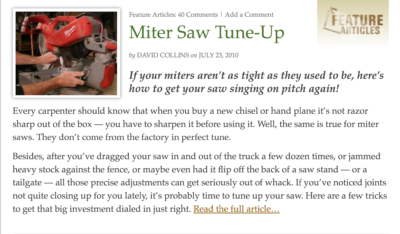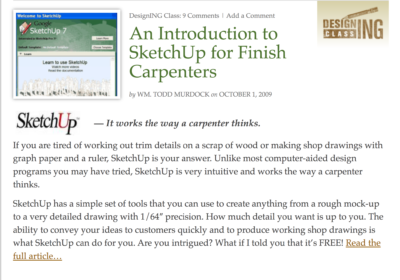I am grateful for living at a spectacular time—a moment in human history when technology has dramatically transformed our lives. As a kid, black-and-white television was still new, the NBC color peacock was a few years away, and Disney’s Wide World of Color didn’t premier until 1961—I was old by then, somewhere between nine and ten.

Technology began to truly affect my life when I began working as a carpenter—nail guns, cordless drills, fast-acting adhesives, sealants that actually worked, bituthene…I could go on and on. I experienced the industry change dramatically each time a new “disruptive” product revolutionized the jobsite.
The changes that most affected me personally were about communication.
Technology completely altered the way in which we communicated; not just the emergence of pagers and then cellular phones, but the lightning-fast transformation of photography.
When I started writing for Fine Homebuilding, all photographs were shot with transparency and slide film—lighting had to be spot on, so we took six or eight photos for every shot, bracketing for insurance. And we took Polaroids to check the lighting, too! Each photograph required a minimum of fifteen minutes. And then there was the terrifying wait for the film development. Digital cameras cracked that task wide open, sped the process up exponentially, and completely eliminated fear.


Roe Osborn & Dean DellaVentura shooting Polaroids for Fine Homebuilding 2003. We had one strobe light outside the window, one behind the camera, and one high on camera left.
But it was the internet that truly opened a world of possibility for me. Driven by an insatiable desire to share the techniques I was learning and the jobs I worked on, for years I published articles in multiple magazines…but it was never enough! I tossed and turned with frustration, with more ideas than magazines could publish, frequently turned down by editorial committees for article subjects I was certain—in my own little world—were exceptional!
Then, at the turn of the 21st century, Craig Savage introduced me to Joe Stoddard. At the time, Joe was the technology wizard behind JLC, their forums, their new web presence, and he built me a website, taught me how to use Adobe Dreamweaver, and even set up an online store for me to sell DVDs. Joe gave me the gift of freedom—freedom to write, photograph, and publish anything I wanted. But that wasn’t enough either!
By then, I was doing Roadshows all over America, meeting talented carpenters at every event. I wanted to help those tradespeople experience the reward of sharing their techniques, their jobsites; establish and grow their own sense of confidence; feel the joy of helping folks in the industry—turn shame into self-esteem.
Craig Flynn, from WindsorONE, introduced me to an online flyfishing magazine: THISisFly.com. Once again, he nagged me: “You should start your own magazine, call it THISisCarpentry.” By now, you’ve probably figured out that I have never had an original idea! I owe so much to so many.
Since the fall of 2008, I have had the honor of publishing a completely free online magazine devoted to craftsmen and craftsmanship, supporting the trades with a variety of articles—from techniques for apprentice carpenters to over-the-top jobs that I would never attempt myself—all written by an alphabet of experienced hands-on tradespeople, folks for whom I have deep respect.
From the beginning I made it a practice to return every email and phone query by the next day—regardless of where in the country I happened to be.
wood-movement/” target=”_blank” rel=”noopener noreferrer”>

And since I made all decisions about what we would or would not publish, I was up front with every author, never dangling anyone in the wind.
And when we published a story, we made every effort to use the author’s original words—to not alter their voice.
I couldn’t have published the magazine without the substantial help of my daughter Tristan—somehow, amidst her Katz Roadshow responsibilities, she managed to edit, layout, tweak photographs, handle publication, advertising, and promotion.
And many of our articles, especially the complicated ones, wouldn’t have been possible without the tireless effort and precision of Todd Murdock, who piloted the art ‘department’ of TiC with the same attention to detail that he applies to a jet at 40,000 ft.
Finally, there is one other behind-the-scenes man who, from the beginning, has been an enthusiastic supporter of TiC: David Luyendyk who owns and operates Yellow House Design and Marketing. David helped us develop the page-flipping format we used for our first few issues, and then he guided and mentored us toward a more user-friendly and less expensive WordPress-based model.


David Luyendyk and his Siberian Husky, Aspen
Over the last few years, we’ve noticed a soft decline in readership—especially now that we can easily see—through analytics—the number and interest of our readers. And tradespeople no longer need the help to publish their work—social media has given each of us the freedom to publish. This also explains why readership is slightly down and video viewership is remarkably high. And that also explains why you should expect to see far more video-based articles in TiC, and far fewer text-dependent stories.
And that brings me back to David Luyendyk. Every past and future TiC author and reader owes David a debt of gratitude for helping generate THISisCarpentry, and for lifting the responsibility from my shoulders as life leads me in new directions.
David—Yellow House Design and Marketing—will be the new publisher of THISisCarpentry. You can expect to see a new website design, new names and contact information, but the same content that supports our trade. Frequency of publication may change some, but I’ll remain actively engaged as editor, and promise to continue responding thoughtfully to email and queries.
One final word of thanks to all the contributors who have helped make TiC what it is, and to all the readers who have supported the magazine. As I said before—and it’s worth repeating—I have been honored to work and know so many of you.









